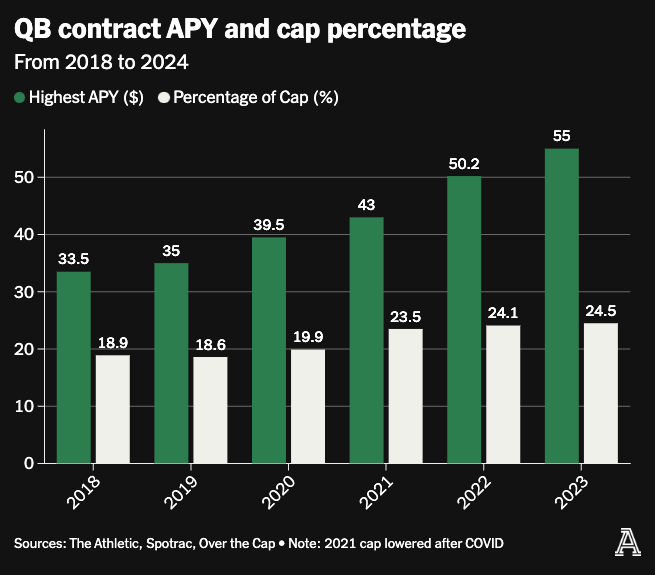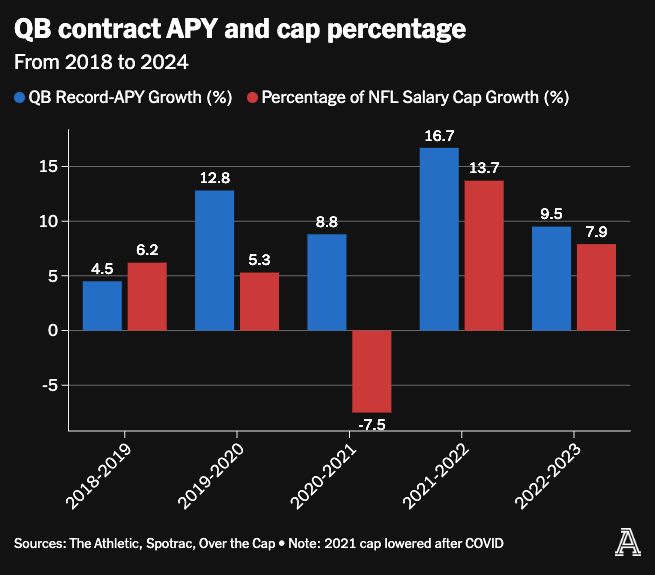This is the online version of Scoop City. If you want it earlier, start every morning with Scoop City delivered to your inbox. Sign up here.
![]()
With Trevor Lawrence’s contract extension imminent and quarterback flashes across OTAs, this article is dedicated to the signal callers. We look at:
- 📈 Inflating contracts
- 📹 What OTAs have shown
![]()
Quarterback Contract Growth: How much has really changed?
If it feels like every other new quarterback contract is “record-setting,” that’s because your feelings are close to accurate.
In 2018, Aaron Rodgers’ extension had a then-record $33.5 million average per year value (APY). In 2019, Russell Wilson’s $35 million per year topped it. In 2020, Patrick Mahomes hit $39.5 million per year. In 2021, Josh Allen earned a record $43 million per year.
Those all look like bargains today. That’s because the NFL salary cap was just $177 million in 2018, a far cry from the current $255 million cap. It is also because of the 89 percent salary floor, which forces teams to spend more money each season.
But there’s more to the quarterback contracts than just number-go-up, right? Let’s quickly explore.
First, NFL teams value contracts based on their APY against the cap. This means Rodgers’ $33.5 million, which covered 18.9 percent of his team’s cap, was actually about as impactful as Jared Goff’s $53 million APY extension signed this offseason (20.7 percent of cap).
The below chart illustrates the per-year salary of the highest APY quarterback (green) and that salary’s cap percentage (white). Salaries and their cap shares have risen since 2018. The latter hasn’t risen as dramatically, but it’s still grown enormous, compared to previous eras.

Not only are star quarterbacks being paid more, they are also receiving a bigger slice of the cap. In 1994, Steve Young’s $4.5 million ate up 13 percent of the 49ers’ cap. Twenty years later, Eli Manning’s $20.4 million claimed just 15 percent. Today, a top passer takes nearly a quarter of his team’s salary, a staggering 63 percent jump from Manning’s 2014 deal.
When we zoom in closer, the pace is impressive. How much faster are QB salaries rising? From 2018 to 2023, the NFL’s highest-paid quarterback saw their APY increase a total of 64 percent, while the NFL’s salary cap increased just 26.5 percent.

And it’s not just the top of the market that has benefitted. The tenth-highest QB salary in 2018, Joe Flacco’s $22 million, covered 12.4 percent of the cap. In 2023, Josh Allen’s $43 million ranked 10th, but still covered 19.1 percent (which is more than Rodgers, the highest-paid QB, took up in 2018).
Advertisement
So, quarterback salaries are rising out of control, right? Yes, but there’s more to it.
How do quarterback contracts keep rising?
When a new, record-setting signing happens, the NFL media jumps on the APY. But average pay is a small portion of the puzzle. There are a few reasons those numbers aren’t as impactful as they appear (figures per Over the Cap):
- Accounting magic. Take Kirk Cousins’ four-year, $180 million deal with a $45 million APY, for example. His 2024 salary-cap charge is just $25 million, a meager 9.4 percent of Atlanta’s cap. His 2024 cash payout, meanwhile, will hit $62.5 million. One option for teams looking to reduce cap hits: paying cash as option bonuses.
- Backloaded, non-guaranteed deals. And that “four-year” deal Cousins signed? It is only guaranteed until 2026, the same year his cap number would balloon to $57 million. Theoretically, he’ll then hand the reins to Michael Penix Jr.
- Void years, a term for spreading salary cap charges across future seasons. A contract can have five void years minus the number of years left. But that bill comes due after a player leaves. So, when Cousins left Minnesota, the Vikings’ use of void years led to a $28.5 million cap hit in 2024 (a bill that they’d avoided in prior years).
- Rookie-deal extensions. Josh Allen signed his six-year, $258 million contract extension in August 2021 with two years remaining on his rookie contract. The extension’s $43 million APY feels misleading, as Allen was due $3.5 million in 2021 and $23 million in 2022. From the Bills’ view, they were getting Allen over the following eight years at $35.5 million APY.
Okay, but these are still massive deals.
Yes, these contracts are a huge portion of what NFL teams spend each year. That takes away from other positions (just ask running backs). And in a league where the median player makes just $860,000 per year, could skyrocketing quarterback costs lead to their salaries being tied to a percentage of the cap?
Hard to say, but since only one team has won a Super Bowl with a quarterback taking over 14 percent of its cap (Patrick Mahomes in 2023, at 17.2 percent), maybe teams should reconsider paying top-of-market extensions for Jordan Love, Trevor Lawrence or Tua Tagovailoa?
Then there’s the rookie contract quarterback. Yes, the last six Super Bowls featured quarterbacks on cheap rookie deals. Those rookie-deal quarterbacks? They went 1-5, and only Mahomes won it at that stage.
The lesson of all this is the same as always: simply draft (and keep) Mahomes at all costs.
OTA Sights and Sounds: Quarterback returns and battles
In New York, they are happy to see Aaron Rodgers return to Jets practice looking like his old self. It’s refreshing to see conversations about Rodgers’ return to football, with the noise around the Jets “a little bit quieter than last year,” wrote Zack Rosenblatt.
- As Rodgers practiced in front of the media for the first time since his Achilles tear, Zack added that “his ability to thread the needle remains at a level the Jets haven’t really seen from their quarterbacks.” Also: Garrett Wilson looks primed for a massive 2024.
In Minnesota, Alec Lewis shared 11 observations: “One thing is very, very obvious after watching J.J. McCarthy for two practices: The velocity cliche of ‘the ball jumps out of his hand?’ I’m not sure it’s ever been more apt for a dude. He has MAJOR juice.”
- Sam Darnold, a willing mentor to McCarthy, participated in workouts for the first time since signing. Darnold played with the first-team offense and threw the most reps in 7-on-7. He’s still expected to start as the Vikings ease the No. 10 pick in.
In Pittsburgh, there is “no chance that [Justin] Fields will be the starting quarterback” in Week 1, writes Mark Kaboly. Fields said he did not plan to sit all year, but Russell Wilson is the Steelers’ opening starter, regardless of how well Fields plays this offseason.
- While Fields’ comments made headlines, Wilson has been impressing teammates like Calvin Austin III (“You know he has everything”), George Pickens (“His personality is great”) and Pat Freiermuth (“Always gets the guys going despite some mishaps in practice”).
In Las Vegas, the competition between Aidan O’Connell and Gardner Minshew began with the two splitting first-team reps fairly evenly. As Tashan Reed noted, “Neither passer lit the world on fire, but O’Connell was more accurate and did a better job of taking care of the football.”
- Expect whoever starts to be the focus of Raiders OC Luke Getsy. “The most important thing is finding a way to maximize the type of guy that you have,” said Getsy, something he struggled to do with Justin Fields in Chicago.
In Chicago, tomorrow marks the first day when media can view Caleb Williams and the veterans during OTAs. It’s obvious this summer will be different for the Bears, who will be watching everything their rookie QB does, along with the rest of us.
And in Green Bay and Los Angeles, eyes are on the contracts of Jordan Love (looking for a raise and extension) and Matthew Stafford (seeking more guaranteed money).
Around the NFL
Speaking of contract markets, Randy Mueller examined Justin Jefferson and the wide receiver market. “How much is too much?”
Wearing the No. 1 jersey can be risky, according to Kyle Shanahan. But Deebo Samuel’s new number marked a return to his college roots. With Brandon Aiyuk still absent, Deebo was Brock Purdy’s favorite target yesterday.
Kyren Williams is dealing with a foot injury and will not participate in Rams OTAs. He has a history of foot/ankle injuries and has missed at least five games each season.
Josh Jacobs has a hamstring injury but shouldn’t be sidelined long. Also participating in Packers OTAs is Jordan Love, who is awaiting a new contract. “It’s everything to us,” Matt LaFleur said of Love’s attendance.
The NFL will test optical tracking for line-to-gain rulings in the preseason, potentially implementing optical tracking for the season. Finally, accurate first-down measurements.
Jacob’s Picks
📕 Meet a “certified power broker.” Alec Lewis shares the fascinating story of Tory Dandy, one of the NFL’s most powerful agents. (The Athletic)
📺 How do NFL contracts work? Back in 2021, The Ringer’s Danny Heifetz broke it down. (YouTube)
🎙 Tom Brady on his journey. The seven-time Super Bowl champion joined The Pivot podcast to talk about football, the roast and self-growth. (Spotify, Apple)
![]()
Sign up for our other newsletters:
The Bounce 🏀 | The Windup ⚾ | Full Time ⚽ | Prime Tire 🏁 | Until Saturday 🏈
(Photo: Kevin C. Cox/Getty Images)




